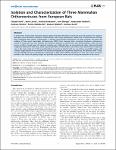Isolation and characterization of three Mammalian orthoreoviruses from European bats.
Kohl, Claudia
Lesnik, René
Brinkmann, Annika
Ebinger, Arnt
Radonić, Aleksandar
Nitsche, Andreas
Mühldorfer, Kristin
Wibbelt, Gudrun
Kurth, Andreas
In recent years novel human respiratory disease agents have been described in South East Asia and Australia. The causative pathogens were classified as pteropine orthoreoviruses with strong phylogenetic relationship to orthoreoviruses of flying foxes inhabiting these regions. Subsequently, a zoonotic bat-to-human transmission has been assumed. We report the isolation of three novel mammalian orthoreoviruses (MRVs) from European bats, comprising bat-borne orthoreovirus outside of South East Asia and Australia and moreover detected in insectivorous bats (Microchiroptera). MRVs are well known to infect a broad range of mammals including man. Although they are associated with rather mild and clinically unapparent infections in their hosts, there is growing evidence of their ability to also induce more severe illness in dogs and man. In this study, eight out of 120 vespertilionid bats proved to be infected with one out of three novel MRV isolates, with a distinct organ tropism for the intestine. One isolate was analyzed by 454 genome sequencing. The obtained strain T3/Bat/Germany/342/08 had closest phylogenetic relationship to MRV strain T3D/04, isolated from a dog. These novel reoviruses provide a rare chance of gaining insight into possible transmission events and of tracing the evolution of bat viruses.
Dateien zu dieser Publikation
Keine Lizenzangabe

